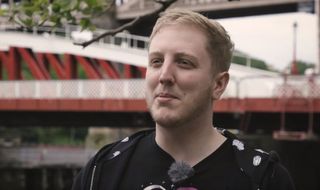What does it take to make a living on Twitch?
Twitch streamers talk about the challenges of "making it," and all the hidden work that goes into a successful streaming life.

For many, making a living from streaming on Twitch is a dream. It's the dream. Twitch's stars appear to earn fortunes by simply hanging out and playing games, all the while bathed in the adoration of their fans. But going professional is a huge challenge. From establishing yourself as a beginner to sustaining a career at the top of the leaderboards, making a living out of Twitch is a difficult balancing act that takes talent, planning, smarts, time, a bit of luck and a whole lot of work.
For many streamers who do make a living on Twitch, the income from streaming alone isn't enough.
But it can work. Twitch is funding Kaitlyn Fox through medical school. For her, Twitch is not about making a fortune. "I have no interest in owning a house or designer clothes," she tells us. In fact, she didn’t set out to be a streamer. "I wanted to be a professional StarCraft player," she says.
For three and a half years she was a professional StarCraft player and streamed on the side. It was a modest income: She made less than $8,000 a year from streaming. But she didn’t ask her audience for money until 2014, to help fund a trip to BlizzCon.
And then, at Christmas, following a personal crisis, she suddenly found herself needing to pay her full rent. It was a make or break moment for her career, and she told her audience what had happened. "My stream donated for it. And from that point on I was able to live off Twitch."
Like Fox, Chris Ball also didn’t see his channel, Sacriel, becoming his livelihood back when he was streaming DayZ. Today, it’s a full-blown business managed by his wife, Shannon Plante, but when they got together (she was a member of his mod team), it was just what he did in his spare time from his job at an internet service provider.
"The only reason Chris went full-time was because of redundancy," says Plante. "We had a lot of conversations about it and I said, ‘You’re young, you don’t have any dependents. So if not now, when?’"
That decision was the start of a long road towards eventually feeling like streaming was actually sustainable. For the first six months, the channel made less than his living costs, but since Ball had redundancy pay from his former job to lean on, he could sustain the losses.
The biggest gaming news, reviews and hardware deals
Keep up to date with the most important stories and the best deals, as picked by the PC Gamer team.
For Kate Stark, Twitch was a more considered decision. She’d been working as a bartender after dropping out of university. "It was not a good environment," she says. "It could be fun, but there were low lows." So at New Year in 2016, she made a resolution to be more creative and decided to start streaming. She could do it alongside her job, and it felt productive.
Six months later, she was making as much money streaming as she did at her job. She’d been thinking she might try to go back to university—but realising it was going well, she kept streaming, steadily exchanging bartending shifts for more time on Twitch.
But Stark was careful. "If I was going to pursue it, it couldn’t be overnight," she says. "I needed to keep a roof over my head and food on the table." After nine months of slowly working towards it, she was full-time.
For many streamers who do make a living on Twitch, the income from streaming alone isn't enough. Stark’s income came directly from her viewers, since she hadn’t yet amassed enough of a following on Twitch to earn directly from the platform. Some income was through requests for tips via PayPal. "I’d say 99 percent of streamers use it," says Stark.
But her most reliable source of income was through her Patreon account, where she committed to send patrons personalised gifts to encourage them to join up. Kaitlyn Fox also supplemented her income with a Patreon, with exclusive vlogs for for $1 a month and tiers up to $20 a month that offer access to extra streams.
Today Fox gets around $300 a month from around 50 patrons, about half of what she once earned through Patreon. "It used to be $600, but I don’t push it at all, because there’s this really negative connotation with Patreon now, especially if you’re female," says Fox. "The vast majority of women who use Patreon use it for lewds; I’ve had mine for a really long time, before that started being a thing."
Six months into streaming, Fox was invited by Twitch to become a Partner. After a long process of building up her channel, she’d finally made it.
Today, Twitch breaks its commercially active streamers into two grades of membership: Affiliate and Partner. Both pay streamers a 50 percent cut of subscriptions they get to their channel, which come in three tiers—$4.99, $9.99 and $24.99. They also get a cut from Bits, which are virtual goods viewers can spend in chat to reward the streamer.
"There’s a lot of additional competition now, but also the barrier to earning income on Twitch is incredibly low," says Plante. "You only need an average of three viewers over 30 days to get on the Affiliate programme."
But even those numbers aren't achievable for everyone. There are thousands of streamers on Twitch at any given moment broadcasting to audiences of zero; some of them will never manage to break out. And even "breaking out" can be a years-long road to making real money from streaming.
According to TwitchStats, there are more than 4000 streamers who average 100 or more viewers per stream. That's a huge pool of competition, and many will never come close to even that level of success. Minecraft streamer Philza broadcast to an average audience of less than 10 viewers for years before a clip went viral, catapulting him to popularity. Only after that lucky break was he able to quit his job and stream full-time.
It is, however, easier than it used to be to earn money through Twitch. Take Fox's experience in 2015, when only Twitch’s Partner programme existed. "It used to need 500 concurrents or something and you didn’t get a sub button," she says, meaning that her income then was just off ads. "I used to leave my stream going after playing and do an AMA and keep rolling ads, because there wasn’t a limit. I’d make $150 a month through that."
According to Fox, it's much easier to get subscribers on Twitch today than it was a few years ago. "People would regularly go to my channel and say subbing is stupid, why would they pay for free content? Fair enough, you really don’t have to! But people were vocally against it."

30 to 40 percent of my time is streaming, and the rest is managing it.
Kate Stark
That attitude is very different now, though, due in part to Twitch launching gift subscriptions, and in part to Twitch Prime, which launched in September 2016. Allowing anyone with an Amazon Prime account to make a free $4.99 subscription each month, Prime caused a boom in subscriptions, and it finally pushed Sacriel into profitability.
"It was insane," says Plante. "It might have been the singlemost beneficial feature that Twitch added to help streamers."
Another thing that streamers can really struggle with is the sheer work that managing a channel demands. From the outside, where it looks like streaming is simply setting up a camera and capture software and then playing a game, it’s difficult to understand that there’s a lot more to it.
"30 to 40 percent of my time is streaming, and the rest is managing it," says Stark. "No one in my audience knows that after I stopped streaming last night at 1.30AM, I stayed up working on a YouTube video, wrote some emails, readied stuff for my accountant."
The pressure has caused Stark to reexamine her Patreon, since she’d promised rewards like hand-made postcards. "I took a mental health step back," she says. "I talked to my patrons and asked them why they were there, what they wanted and what I could offer, and most of them just said they wanted to help contribute and make sure I kept streaming."
Sacriel failed to balance his workload in his early years, during the period Plante calls Twitch’s Wild West era.
"Anybody at that time who was full-time streaming was doing 40-60 hours, and then additional hours on top of that. I couldn’t think of a single streamer who didn’t overdo it, who didn’t give up healthy eating or working out, or seeing family or having a social life or taking holidays."
"Holidays? That’s a joke," says Stark. "I took a holiday last year for the first time in five years, where I didn’t stream or vlog. I was offline for two weeks. It was amazing." But she had to spend the ensuing weeks building her followers back up again.
At Sacriel’s level, however, he’s able to take advantage of a service provided by his management company, Online Performers Group. OPG’s policy to give back 5% of its management fees to a streamer if they take five days off every six months.
"We want them to be in the business for 10 or 30 years, for their career," says OPG CEO and founder Omeed Dariani. "That’s limited if they die! And if they’re stressed, then they’re not good at broadcasting. We can’t do paid vacation because they’re not employees, so we give refunds if they take 10 days off a year."
Not that all OPG’s streamers take advantage of it. After all, some, like CohhCarnage, are proud to perform 2000-day streaks, simply because they’re energised by streaming.
Maybe CohhCarnage is also influenced by the metrics. Like all modern social networks, success on Twitch is reflected by numbers, and they heavily influence streamers’ lives.
"You can dictate to yourself that you’ll take a normal work week, but if you look at your dashboard while you’re broadcasting and notice your viewership isn’t what it was, there’s an overwhelming temptation to get back on and always be broadcasting," says Plante.
That constant pressure goes hand-in-hand with the natural ups and downs of the wider industry, with the ebbs and flows in audience and sponsorship money that come with annual events like Christmas and E3, and big game releases.
"We had to learn that there would be massive ups and downs, and that in those downs, it doesn’t necessarily mean your channel is dying, there’s just not much going on in the industry," says Plante.
Fluctuation affects everyone on Twitch, big and small. "If you value a stable wage, it’s not the job for you," warns Stark. But as somewhere to make a living, Twitch is a lot more stable than it used to be, partly because it’s so much better understood.
"Typically you can count on reliability with your paid subs, and then rely a fair bit less on your Prime subscription numbers staying the same every month, and never rely on sub gifts," suggests Plante.
Still, though, for streamers like Fox, who is streaming while earning her medical degree, and often streams from her phone in hospital on-call rooms, streaming is still fun. "I get antsy if I don’t stream much. Any time I feel burned out, I can do it again the next day," she says. That may ultimately be the most important personality trait for a successful streamer: To really love streaming.
"Never go into it with the end goal of being full-time with tons of cash," advises Stark. "Only a small percentage can do it. But if you love it, like me, then that’s the reason to start."
"I have to decide the kind of doctor I’m going to be so I can keep streaming," says Fox. I want to be a surgeon, but I’m not sure they go hand in hand. Maybe emergency or family? I don’t ever want to stop."
Most Popular



